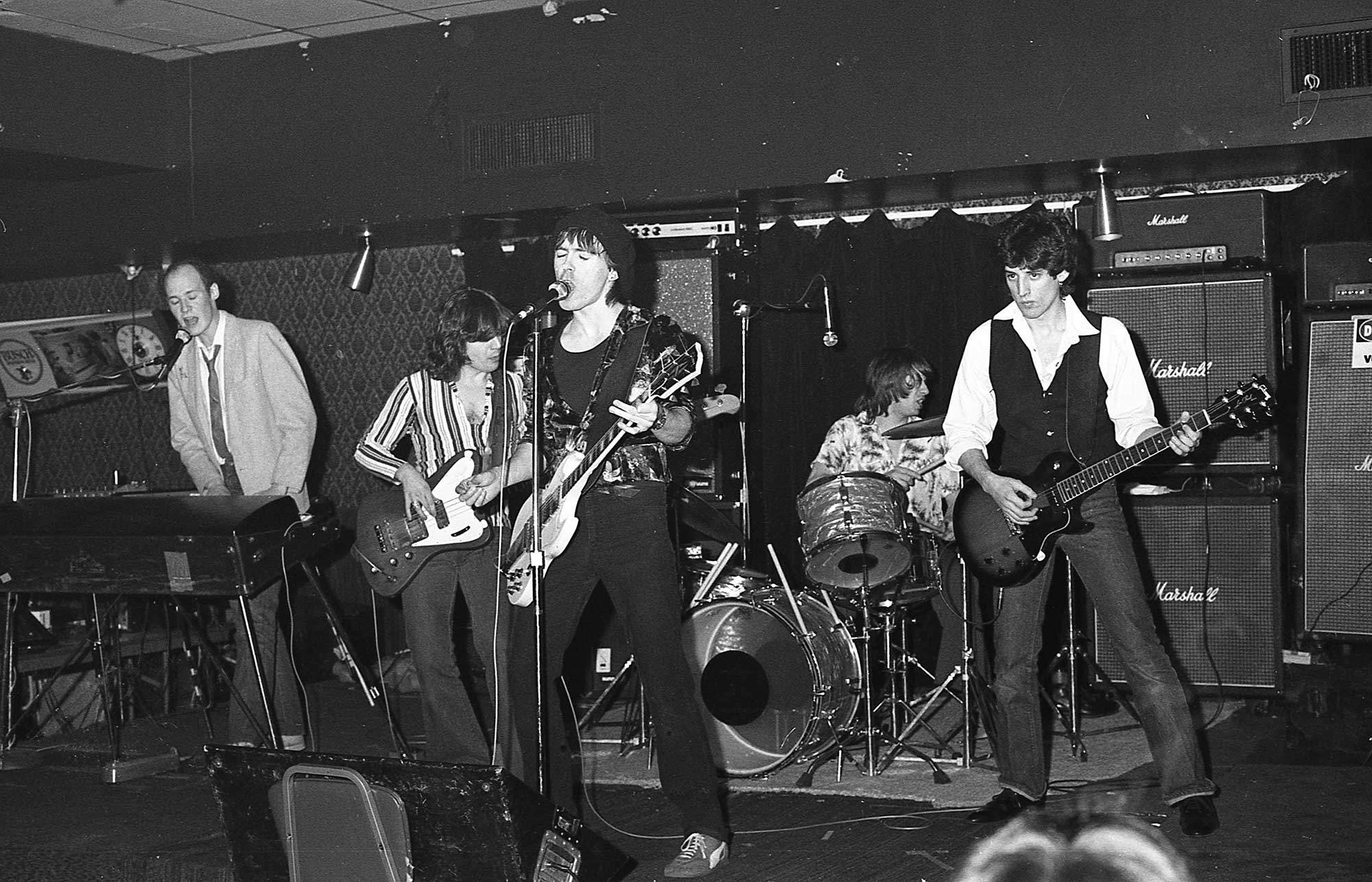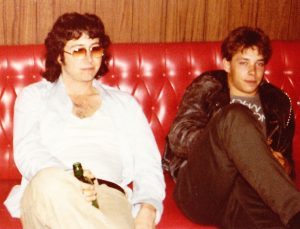By Tom Campbell
Break’er Records | Minniepaulmusic.com
Tribute to Jay’s Longhorn Concert February 9, 2019
I went to the Parkway on Chicago Avenue last night to check out some of the Longhorn bands playing as a tribute to Jay’s Longhorn. Local musician Mark Engebretson put the show together.
In June, 1977, The Longhorn Café and Music Emporium, a jazz club in downtown Minneapolis made a transition to Jay’s Longhorn — which featured local (and national- international ) New Wave rock bands.
I still recall the first time I went to the Longhorn to check out the Suicide Commandos (winter of 1977) who were getting covered in the local newspapers. When I walked into the main room the Commandos were playing their opening song “Mark He’s a Terror.” It was like walking into a parallel universe. Compared to other clubs with live bands, this was completely different than what I had experienced. They played loud and they played fast. The majority of their set consisted of original songs that were quirky and short — many were only two or three minutes long, some even shorter. The cover songs they played (such as “She” by the Monkees and “Bit’s and Piece’s” by the Dave Clark Five) were unusual choices to say the least.
The Commandos were a three-piece band: Steve Almaas on bass guitar and vocals, Chris Osgood on guitar and vocals, and Dave Ahl on drums and vocals. I never heard a band play so loud. It sounded like there were three bass guitar players, three guitars players, and three drummers. The Longhorn was basically a concrete building and the sound waves bounced off the floors, walls, and ceilings, engulfing the listeners in a sea of rock music. You could touch the concrete block walls and feel them vibrating.
In addition to sounding different, the band looked different… like kids… dressed in jeans, T-shirts, and tennis shoes. And they had short hair. Most local bands still had the long-hair “hippie” look.
And then there was their attitude. They rammed through their set list at break neck speed, barely stopping long enough between songs to say, “Thank you very much” and then on to the next tune. They were very confident in their music and it was quite obvious they were having fun.
The fun was contagious.
There were usually people dancing for each song… but not “normal” dancing. It was freestyle, no rules, anything goes. Many bounced up and down in the same place (“the Pogo”). Others had variations on this strange new dance. People danced alone, some in pairs, some in groups… it didn’t matter. Having fun mattered.
I stood in the back and observed it all. It was a lot to take in and process. Sensory overload for sure.
In the mid-1970s most bands in Minnesota (and elsewhere) were playing cover songs in the popular laid-back, California style of light rock or country rock. Not the Commandos. They seemed to have connected to the raw sound of the 1960’s garage bands and morphed it into their own unique style. The Commandos were the “big bang” in local new wave music and they inspired many local bands to jump in the fray and give it their best shot.
Other than the Commandos, the only other bands playing the Longhorn at that time were Curtiss A and Flamingo. Soon to come were the Suburbs, the Hypstrz, Fingerprints, NNB, Hüsker Dü, the MOR’s, Wilma and the Wilbers, the Replacements, Shock Treatment, and many, many others. During the band breaks, there was a “DJ Booth” with people spinning records by New Wave bands from the USA and across the world. For many people, including myself, this was the first time we were hearing these records.
I was soon going to the Longhorn three or four nights a week. I was caught up in the excitement. You could “feel” it in the air. New bands emerged — 45’s, EP’s, and albums were being released by local bands. The Commando’s had an album out on a subsidiary of a major label.
Hopes were high in those days. We were going to reclaim the airwaves with the kind of rock music we liked and dispatch with the “classic rock” format that was playing the same old songs over and over again. The “dinosaur” bands would be forced into retirement and the New Wave bands would take over the music business. The “super star” system in the music world would be dismantled. Independent record labels would rise up and diminish the power of the major record labels. We were on our way.
It didn’t happen.
The times had changed. In the 1960s local rock bands like the Underbeats could record a 45 at Kay Bank and bring the acetate over to WDGY on the same day and Bill Diehl would play it on the air and it would soon be climbing the “WeeGee” radio chart. Starting around 1970 or so, the radio stations began to “tighten up” their play lists. They paid little or no attention to local bands (of any kind) and focused on playing “safe” records — the ones people had heard on the radio a million times. By the mid-1970s the “classic rock” format was dominating the airwaves with no place for any new bands. Not only did the radio stations shun the local new wave bands, they refused to play new wave music by national bands such as the Ramones. These bands were too risky to take a chance on. Strange, because the radio stations had no problem taking chances with the Doors, Hendrix, Joplin, Zeppelin, Iron Butterfly, and other “underground” acts in the later 1960s.
For a band to succeed they need to have records on the radio. Airplay is their lifeline. Without it they cannot survive. To have a “scene” at one club in one city is a good thing but does not provide enough momentum to launch new bands to a wider audience. The reality of the music business was in no way “friendly” to the new bands that were out to forge a “new sound” — in Minneapolis and other cities across the country. Record companies were not impressed with bands that could sell 500 45’s in their own city. Large booking agencies had no time for bands that could draw a couple hundred people on a weekend night.
And then in the fall of 1978, I heard the news: The Commandos were going to call it quits. I could not believe it. They were the leaders of the New Wave rock scene in Minneapolis. It made no sense to me. This was not supposed to happen. But it did.
And then the time arrived. The Commandos were going to play a series of final shows in November 1978.
On the day of their final show, November 24, 1978, I thought about getting a photo of the Marquee at the Longhorn that said COMMANDOS COMMIT SUICIDE. I knew if I waited to shoot the photo when I went to the last show that night it would be too dark to get a decent photo, so I drove downtown during the day to make sure I got a good shot of the marquee. I felt it just might be an important photo at some point in time. Forty-one years later, Mark Engebretson informed me the photo will be used in the documentary film on the club.
And now, four decades after the Commandos last appearance at the Longhorn, there was a concert at the Parkway on February 9, 2019 that featured seven bands from the Longhorn era: Smart Alex; Yipes; Hypstrz; Fingerprints; Flamingo; Commandos; Curtiss A. The concert was sold out. I found a seat in the last row and took some notes.
- Smart Alex opened up with a set of power-pop songs including their 45 of “Chitter Chat” which I understand sells for big bucks these days.
- Yipes used to play the Longhorn on Sunday nights. They are actually from Milwaukee and their most commercial song “East Side Kids” was released on a 45. As I recall they had two albums out on a major label.
- The Hypstrz are kind of like a live “Pebbles” band that plays a lot of the more obscure garage songs from the 1960s, including “Talk Talk” (Music Machine) and even “Action Woman” by our very own local band the Litter. These guys play even faster than the Commandos it seems.
- Fingerprints did a nice version of “Down” that was out on a 45 and of course they played “Space Girl” which was on their EP. I was hoping to hear some of the Iggy Pop songs they used to cover. Each set was about a half hour so that puts limits on the set list. Mark Throne, lead singer, seemed to be in a mellow mood.
- Flamingo sounded good as always. Their set included fan favorites “I Do What I Like” and “I Remember Romance.” They played a recently penned tune called “Blue Valentine,” which sounded very commercial. The crowd loved their version of “Jumpin’ Jack Flash,” which was typically their final song back in the Longhorn days. They still have a strong fan base in town and play around the cities now and then.
- The Commandos started off their set with a couple of newer tunes and then launched into some of their classic originals including “Attackin’ the Beat,” and “I Need a Torch” among others. Chris took on lead vocals for “Complicated Fun,” which I recall was actually used for a Target commercial some time ago. Dave did his “tongue in cheek” lead vocals on “She” by the Monkees. No one plays more notes per bar on a bass guitar than Steve Almaas. The guys still have it. No question.
- Curtiss A joined the Commandos for “Land of the Free” and belted out the tune in his raspy screamer style voice. I checked the clock after that set and decided it was time to depart.
As I drove home I recalled the nights driving home after going to the Longhorn, filled with optimism about the local New Wave rock scene (which “transferred” over to the 7thStreet Entry around 1980 or so.) The reality of what did happen as opposed to what was “supposed” to happen — or what “could” have happened is a bit sobering. Only a few of the New Wave bands had varying degrees of success in the music business and this seemed to come about many years after the Longhorn era.
If you drive by the former building that was the Longhorn (14 South Fifth Street) there is not much to see these days. It’s a small, nondescript building wedged between the towering, Romanesque style Lumber Exchange Building to the west and a parking ramp to the east. The building is being used as a storage facility for a local energy company. Pull over and roll down the window and you just might be able to hear the faint echoes of rock music from the new wave era.


